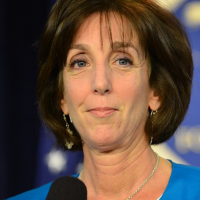United States Ambassador to Mexico Resigns: Who Was Roberta Jacobson?
 Roberta Jacobson
Roberta Jacobson
The brain drain at the State Department sucked away another career diplomat recently, as U.S. Ambassador to Mexico Roberta Steinfeld Jacobson announced her decision to resign on March 1, 2018. Coming just a few days after special envoy for North Korea Joseph Yun announced his retirement, and weeks after undersecretary of state for political affairs Thomas Shannon did likewise, Jacobson’s exit weakens U.S. diplomacy with Mexico and underscores the deepening crises in U.S.-Mexican relations and within the State Department as a whole. Jacobson’s resignation is effective May 5, short of two years after she started in Mexico City.
Present Obama named Jacobson ambassador on June 1, 2015, her first ambassadorship and second embassy post, having spent her entire State Department career working on U.S.-Latin American relations. Her nomination was not approved by the Senate Foreign Relations Committee until November 10, and not approved by the full Senate until April 28, 2016. Fluent in Spanish, Jacobson was the first woman to serve as U.S. ambassador to Mexico after 55 men served in that position or its equivalent.
Born April 14, 1960, Jacobson is from Englewood Cliffs, New Jersey. Her father, Julian Steinfeld, was vice president and a principal of Mid-Island Electric Supply. Her mother, Gloria Steinfeld, was supervisor of family and neighborhood counseling for the Bergen County Department of Health Services. Roberta Jacobson earned her BA from Brown University in 1982 and worked for the United Nations Center for Social Development and Humanitarian Affairs from 1982 to 1984. She returned to school to earn an MA in International Relations, concentrating in U.S.-Latin American relations, from the Fletcher School of Law and Diplomacy at Tufts University, in 1986.
Jacobson entered the State Department in 1986 as a presidential management intern and was assigned to the National Security Council for a time in 1988. She then began her long career with the Bureau for Western Hemisphere Affairs, working directly for the assistant secretary, first as special assistant from 1989 to 1992, and then as executive assistant from 1993 to 1994. Jacobson served as the Bureau’s coordinator for Cuban affairs from 1994 to 1996, and from 1996 to 2000, she was director of the Bureau’s Office of Policy Planning and Coordination, covering issues such as civil-military relations, human rights, foreign assistance, presidential travel, and counter-narcotics.
Jacobson’s first overseas posting came in 2000, when she was named deputy chief of mission (DCM) at the U.S. Embassy in Lima, Peru, where she served until December 2002, during the fall of the Alberto Fujimori regime and the creation of the truth and reconciliation commission. Her appointment brought criticism from the Foreign Service community as DCM posts are, by State Department regulations, supposed to go only to career Foreign Service employees. Jacobson is not a foreign service officer.
Returning stateside, Jacobson served as director of the Office of Mexican Affairs from December 2002 to June 2007, and as deputy assistant secretary for Canada, Mexico, and NAFTA issues from June 2007 until December 2010.
Jacobson served as principal deputy assistant secretary from December 6, 2010, to July 2011, with responsibility for regional political, security and economic issues. In addition, she was the senior coordinator for the State Department’s “Security Initiatives” in the Western Hemisphere (Merida Initiative, Central America Regional Security Initiative, Caribbean Basin Security Initiative, and Colombia Strategic Development Initiative).
Jacobson took over as the State Department’s acting assistant secretary for Western Hemisphere affairs on July 18, 2011. On September 27, Obama nominated her to be assistant secretary, and she was finally confirmed by the Senate on March 29, 2012.
As assistant secretary, much of Jacobson’s work involved negotiations with Cuba leading up to the normalization of diplomatic relations. Her success in those efforts created problems when her nomination came up for a vote in the Senate, as Republicans delayed the vote for eleven months.
Jacobson has written several articles, including “The United States and the Western Hemisphere: A Relationship on the Rise” (Ambassador’s Review; 2015), “Women and the Rule of Law: A View from the Americas” (Fletcher Forum ff World Affairs; 2014), “10 Things You Didn’t Know About U.S. –Latin America Relations” (Americas Quarterly; 2013) and “Liberation Theology as a Revolutionary Ideology in Latin America” (Fletcher Forum of World Affairs, Summer 1986).
Jacobson’s husband, Jonathan, works for the Environmental Protection Agency. They have two sons, Gil and Daniel.
-Matt Bewig
To Learn More:
U.S. Ambassador to Mexico: Who Is Roberta Jacobson? (by Matt Bewig and Steve Straehley, AllGov)
State Official Makes Her Mark on Rising Western Hemisphere (by Larry Luxner, Washington Diplomat)
Statement of Roberta S. Jacobson (pdf) (Senate Foreign Relations Committee)
U.S. Ambassador to Mexico Stepping Down (by Nahal Toosi, Politico)
U.S. Ambassador to Mexico to Quit Amid Tense Relations Under Trump (by Azam Ahmed, New York Times)
- Top Stories
- Unusual News
- Where is the Money Going?
- Controversies
- U.S. and the World
- Appointments and Resignations
- Latest News
- Can Biden Murder Trump and Get Away With it?
- Electoral Advice for the Democratic and Republican Parties
- U.S. Ambassador to Greece: Who is George Tsunis?
- Henry Kissinger: A Pre-Obituary
- U.S. Ambassador to Belize: Who is Michelle Kwan?






Comments